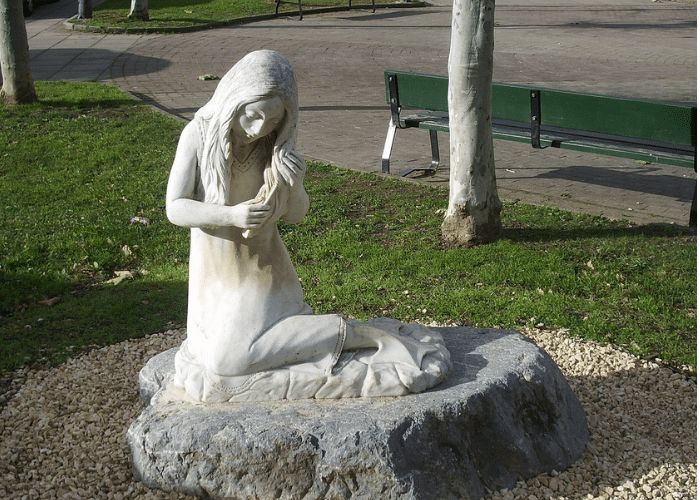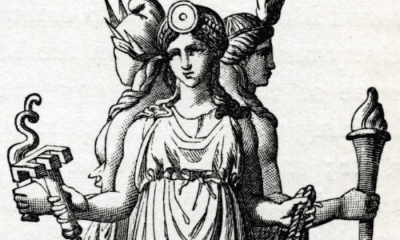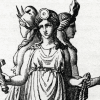
Greek
What is the Lamia?
What is the Lamia?
Of all the monsters in Greek mythology, the Lamia may have been the most terrifying there was. The horrific monster of Greek mythology changed forms and legends, but she continued to haunt the young people of the region for thousands of years!
In almost every culture of the world, children grow up hearing about dangerous monsters that will grab them up if they don’t obey their parents. Meant to caution children against reckless behavior and disobedience, such monsters are a common feature of folklore that serve a practical purpose.
Few of these child-eating monsters are as terrifying as the ancient Greek Lamia. Once a beautiful woman, she became a hollow-eyed shark who stalked the land at night searching for children to devour.
The Lamia was used to scare children throughout the ages in Greece, but in the medieval era both her form and function changed.
How was the horrific and hideous Lamia recast as a seductress who threatened young men’s souls as well as their mortal bodies? Read on to find out how the Greek Lamia was used to frighten Greeks long after her myth had been forgotten!
The Terrifying Lamia
According to most Greek writers, the Lamia had once been a beautiful young queen in Libya. Like many beautiful young women in Greek mythology, her story began when she attracted Zeus’s attentions.
The two had an affair and Lamia gave birth to at least two of Zeus’s children. In time, however, Zeus’s jealous wife learned about her husband’s Libyan queen.
In most versions of the story, Hera kidnapped Lamia’s children. It was unclear whether she had them killed or if she had simply sent them away to be raised by someone else in secret.
There are even darker versions of the story, however. In those, Hera forced Lamia to kill the children herself.
The loss of her children was enough to drive the Libyan queen insane with grief. But Hera had more in store for her.
Hera deprived Lamia of the ability to sleep, driving her even further into madness. In some versions of the story Zeus tried to alleviate her suffering by giving her removable eyes so she could rest, while in others she tore her eyes out herself in her madness.
Consumed by thoughts of her lost children, the mad Lamia began looking for others wherever she could find them. She killed every child she found when she realized it was not one of her lost offspring.
As she became more and more obsessive and cruel, her appearance began to match her actions. She was a daughter of Poseidon, and she began to resemble a sea monster more than a woman.
The Lamia was usually shown as a monstrous, shark-like woman. She took on almost vampiric traits, hunting children at night or tearing unborn babies from their mother’s bodies in her mad search for the babies she had lost.
The Lamia became a cautionary tale for disobedient children, similar to stories of the bogeyman or Bloody Mary that are used to scare kids today. Children were warned that if they wandered out of sight or didn’t behave, the Lamia would snatch them up and eat them alive.
My Modern Interpretation
Most cultures around the world have invented some type of cautionary monster to keep people in line. Frightening children with monsters who will catch them if they stray too far from home was an almost universal feature of mythology.
The figure of the Lamia changed, however, as its society did.
As Christianity replaced paganism as the dominant religion of the Greek world, the old myths were replaced with Biblical tales. The old monsters still remained in local folklore, however, and lamia became a general term for any monster that might lurk in the dark.
She was not just used to scare children, though. A 4th century edition of the Bible in Greek translated the Hebrew name Lilith as Lamia, creating a previously nonexistent link between the bogeyman of Greek folklore and the first wife of Adam.
Lilith had already become cast as the mother of all manner of monsters, including vampires and succubi. The name Lamia had also been used locally for other demons, making the connection even more sinister.
Because the figure of Lilith was associated with more adult hazards, the Lamia ceased to be a cautionary tale for children. Recast as a seductress, she instead lured young men away from the morality and values of Christianity.
This Lamia was a shapeshifter who made herself a beautiful woman to tempt young men to follow her. She drank their blood, with some stories saying that she preferred young men because their innocence and purity made them taste sweeter.
Lamia in the Christian era was a monster who tempted young men away from purity and the values of the church. Using her feminine charms, she preyed on the weakness they showed in following physical pleasures rather than the teachings of the Bible.
The Lamia was always used as a cautionary figure, meant to inspire obedience through fear. Her form and function changed, however, to fit the demands of her era.
In ancient Greece, the Lamia was a threat to children who wandered out of sight or refused to obey their parent’s commands. Like a real wild animal or kidnapper, she could snatch a child up in an instant if they did not stay close to home and do as they were told.
Parents in every culture have always feared for their children’s safety, and the Lamia was that fear put into a terrifying form.
The later Christian version of the Lamia represented a fear that was particular to its time and place. While parents feared abduction or an animal attack, early Christian society feared a loss of morality that could lead to eternal punishment.
Like many Christian demons, she was dangerous specifically because she was attractive. Being distracted by desire could lead young men astray with serious consequences to the state of the soul, if not their lives.
The medieval Lamia still served as a warning, but to a different audience and culture. She had been transformed from a monster who lept out of the darkness to a seductress who lured her victims in.
In Summary
The Lamia was a monster in Greek mythology. Once a beautiful Libyan queen, Lamia had a long affair with Zeus.
When Hera found out, she took her revenge by driving Lamia to the extremes of madness. In the end, the Lamia was an eyeless, shark-like beast who roamed the countryside searching for her lost children.
When she found a child and realized it was not her own, she ate it alive.
The Lamia was part of a worldwide tradition of monsters who were used to frighten the young into caution and obedience. Greek parents used the Lamia as a threat against wandering too far away or disobeying their rules.
With the Christian era, the Lamia faded into folklore as a generic monster. But a few imaginative translations of Biblical texts made her name synonymous with a moral rather than physical danger.
This new Lamia was a seductive demoness who lured young Christian men away from the path of god. She used her feminine wiles to tempt them into sin, then killed them for their lifeforce.
The Lamia was still a cautionary monster, but one that represented a different threat for a different audience. Rather than a monster in the shadows, she was the metaphorical threat of sexual impropriety and straying from the rules of the church.



